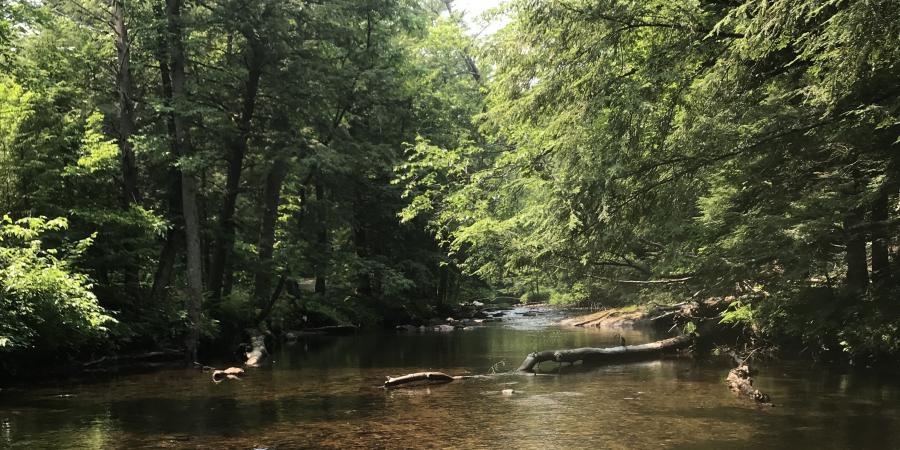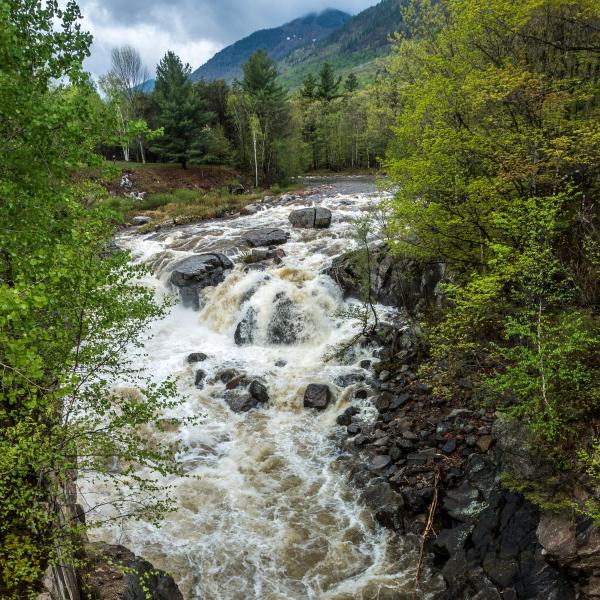What is Hemlock Woolly Adelgid?
A Hemlock woolly adelgid (HWA) is a tiny insect that feeds, develops, and reproduces on hemlock trees. While they inhabit all hemlock species, they only attack Carolina and Eastern Hemlocks. There are two generations of HWA each year. Eggs laid in the spring develop into crawlers. This is the only mobile stage of HWA. They either crawl along the branch, get blown by the wind, or get transported by birds or other animals. If they remain on or are transported to a hemlock tree, they find a place to settle on the underside of a branch, usually at the base of a needle, and insert their mouthpart. After they have inserted their mouthparts, they can no longer move; this is where they will spend the rest of their lives. They are inactive during the summer, waiting until the fall and winter to feed, grow, and produce wool. It is this wool that makes them visible without magnification. In early spring, the HWA lay eggs creating a second generation that quickly matures and lays eggs of their own, continuing the cycle. In the Eastern US, all HWA are females that reproduce asexually, meaning just one HWA can produce a new population.
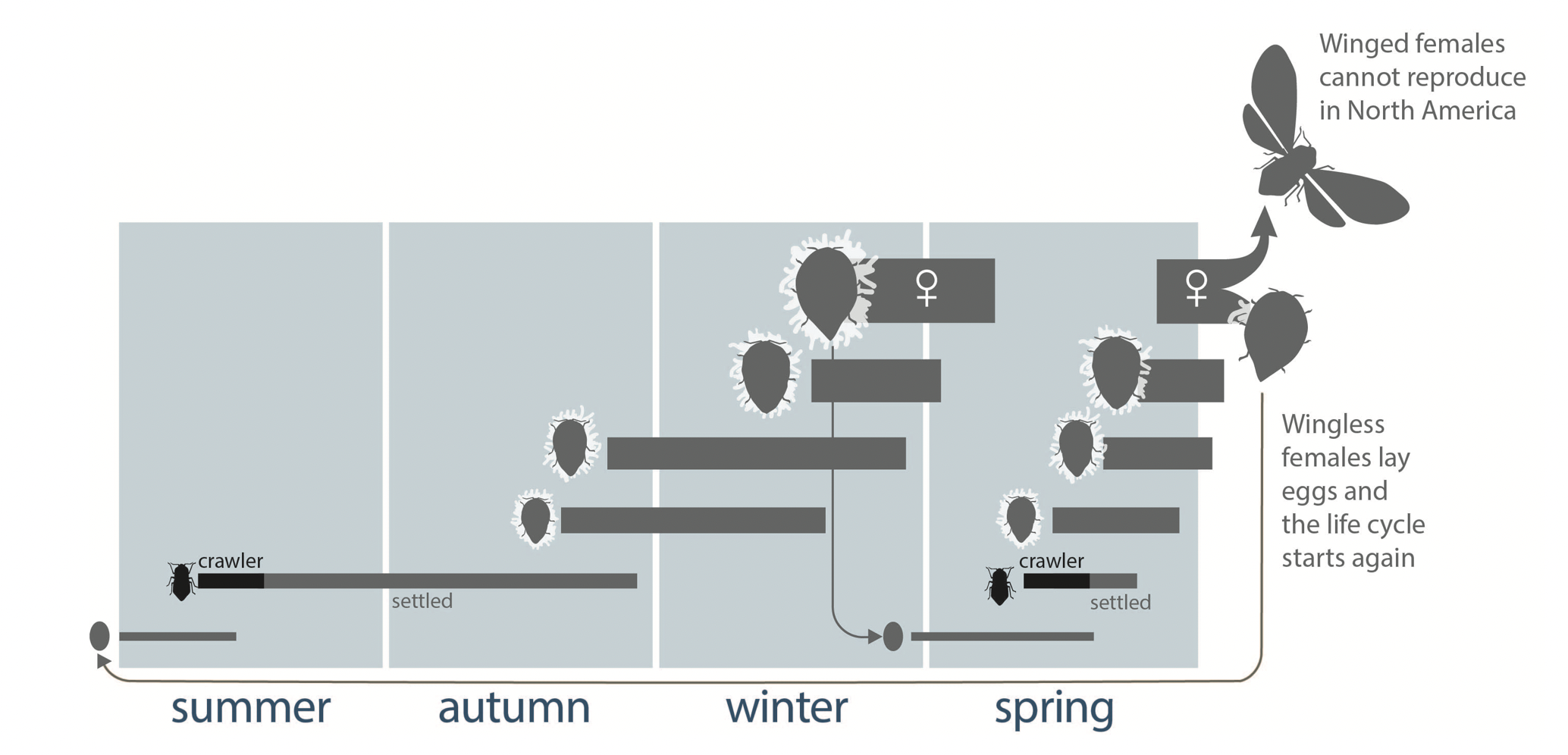
Simplified life cycle of hemlock woolly adelgid in the Eastern United States. Illustration by N. P. Havill and V. D'Amico.
How do HWA Damage Hemlock Trees?
HWA insert their mouthparts into the twig to feed on the starch reserves of the hemlock. This, however, is not what kills the hemlock tree. Each time a HWA inserts their mouthpart into the branch, it damages the tree. The tree walls off this part of the branch, creating scar tissue. This is the strategy trees use anytime they are damaged. This doesn’t hurt the tree but when hundreds and thousands of HWA penetrate the trees’ branches, so much scar tissue builds up that the tree is unable to get nutrients and water out to the end of the branches to be able to grow new foliage. Without new foliage, the tree is unable to collect energy from the sun to create food. The tree will begin to starve, resulting in a decline in tree health and eventual mortality of the tree, generally within 4 to 10 years.
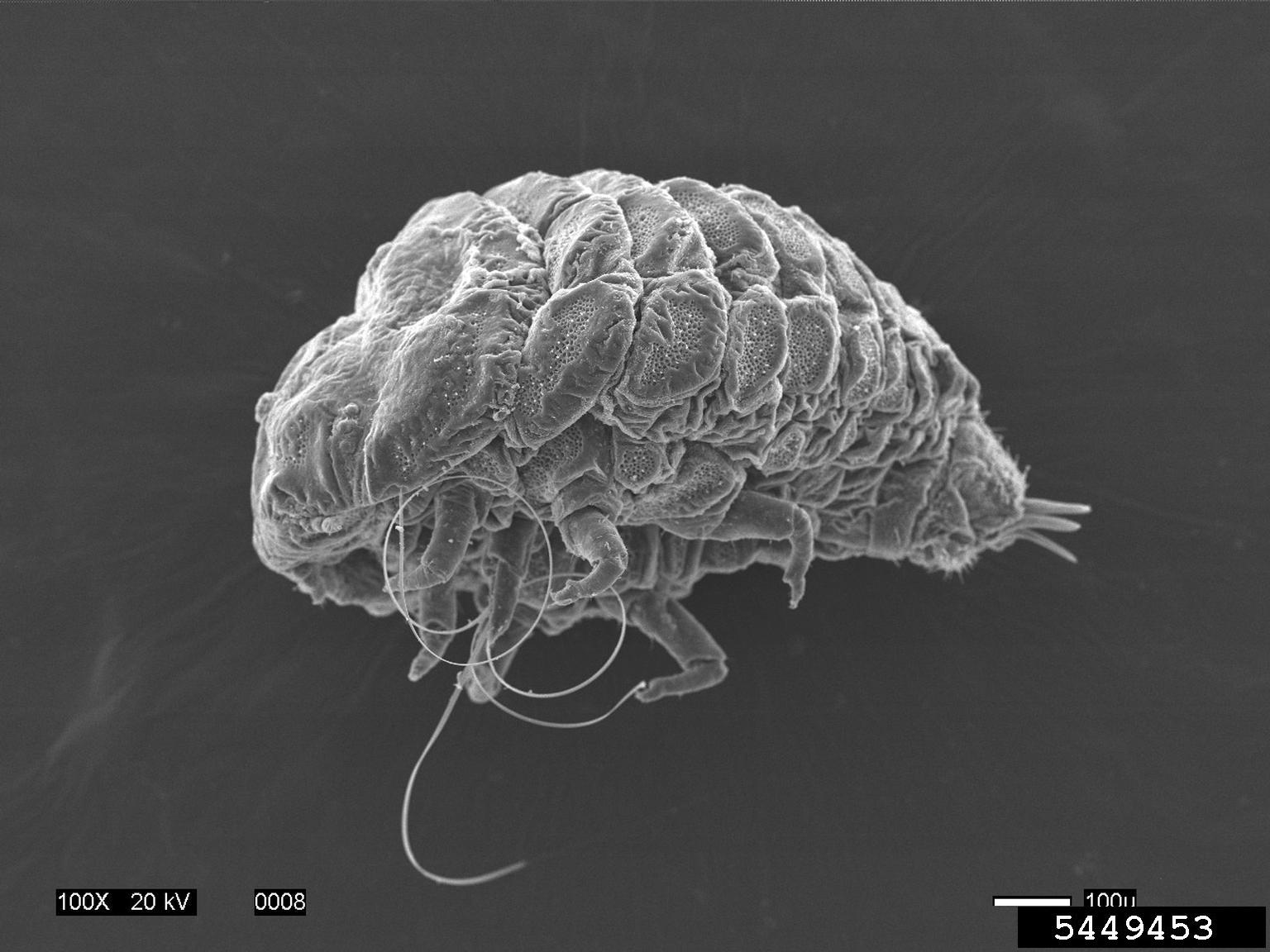
Close-up of Hemlock woolly adelgid and mouthpart used to penetrate branch of Hemlock tree to feed. Photo by Kelvin Tryon.
How is HWA a Threat to the Adirondacks?
The obvious threat of HWA is the loss of Eastern Hemlock trees. Unfortunately, the threat is larger than the loss of one species. Eastern Hemlock is the third most abundant tree species throughout New York State. It is a foundation species that greatly influences the ecosystems it is a part of. Under its canopy in the summer, air temperatures can be 10 degrees Centigrade cooler, and, in the winter, the canopy keeps temperatures warmer. Because of this, hemlocks provide a refuge for wildlife like deer and moose in both seasons. Not only terrestrial species benefit from hemlocks however. Eastern hemlocks are found along the banks of many of our streams and rivers. Their extensive root systems stabilize streambanks, reducing erosion and sedimentation, and their cooling canopy also shades the stream keeping water temperatures cooler. The loss of this species has implications for entire forest and aquatic ecosystems. If Eastern Hemlocks are lost, other important Adirondack species, such as brook trout, could be greatly challenged, or lost as well.
Support our biodiverse habitats work for wildlife and their aquatic and near-stream habitats. Give with confidence today!
Where is Hemlock Wooly Adelgid Found?
Hemlock wooly adelgid, (HWA) is native to Asia and the Pacific Northwest but has spread beyond its native region. In eastern North America, where it is an invasive insect, HWA is found as far south as Georgia and Alabama, as far west as Michigan and as far north as Novia Scotia. HWA was first discovered in New York in 1985. In 2017, HWA was identified in the Adirondack Park in the Town of Lake George. Since then, there have been several other locations in the Lake George region where HWA have been found. The Ausable River Association and regional partners like the Adirondack Park Invasive Plant Program (APIPP) are working with citizen scientists to monitor the spread in Adirondack forests.
How do you get rid of Hemlock Wooly Adelgid?
The two primary management options for HWA are chemical and biological controls. Chemical management is being used today, while biological controls continue to be carefully researched. Imidacloprid and dinotefuran are the two active ingredients used in chemical treatment of HWA. While imidacloprid is slow-acting and long-lasting, dinotefuran is quick-acting and short-lived. The best management practice for the treatment of HWA using either of these active ingredients is through a basal bark application that can only be carried out by a certified pesticide applicator. While chemical controls provide a means of management right now, biological controls hold promise as a long-term solution.
There are currently two biological controls being researched in New York. These are Laricobius beetles and Leucopis silver flies. Both of these have been strategically released throughout the region and scientists are now looking to see if they have become established at release locations. Because the research on biological controls is a long process, there is still a lot of work to be done before we can count on these biological controls. They do however provide hope that we can find a tool to save Eastern hemlock from HWA.
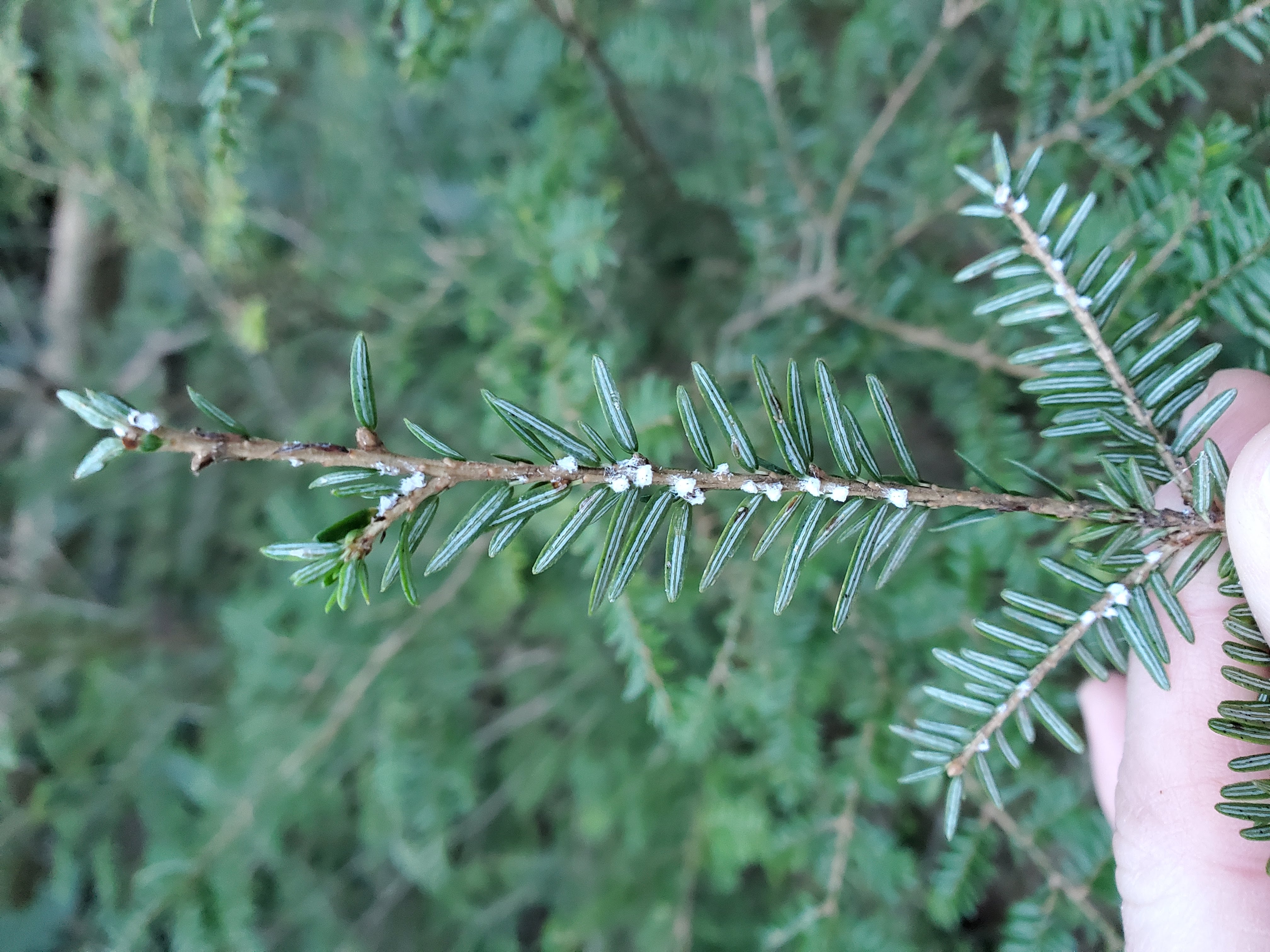
Hemlock woolly adelgid found on the underside of a branch during a December survey in Central Pennsylvania.
What can I do about Hemlock Wooly Adelgid?
For HWA, as well as all invasive species, early detection is key. You, citizens of the Ausable watershed and beyond, can play a very important role in the management of HWA by using local firewood, shopping at local nurseries, and volunteering to survey for HWA.
- Don’t Move Firewood: Be diligent in not transporting firewood, either for camping or for heating your home. There are so many self-serve local firewood stands near campgrounds now, you should never need to bring wood from home. Share this message with friends and family, too.
- Shop at Local Nurseries Only: If a nursery is in an area that has HWA, the nursery stock may also be infested (remember that HWA is very difficult to see in the spring and summer). By planting a tree from that nursery in a new area, you could be spreading HWA. This is a common way that HWA is spread to different states. Other invasive species (e.g., emerald ash borer) can be spread in other tree and plant species as well. Shopping at your local nursery not only reduces your risk of spreading invasive species, but it can help your plants grow better when they are already adapted to the local climate.
- Volunteer to Survey for HWA: There is a lot of ground to be covered in the search for HWA and we cannot do it on our own. If you are a landowner with hemlock trees, check them for HWA. If you like to hike, snowshoe, or ski, check for HWA on your trips. The best time to survey for HWA is November through April 15th. This is when they are producing the wool that makes them more easily visible. After mid-April, the eggs start hatching into crawlers that can be transported so it is best to stop surveying by then to reduce the risk of aiding their spread. During your survey, check the trees that are along the trail. Grab the branches you can reach and turn them over to check for fluffy, white patches along the underside of the twig (you can also check for two white lines on the underside of the needles to makes sure you are checking a hemlock). Make sure you download the Imapinvasives app so you can report any findings.
Story by Liz Metzger, Research Associate.
Sign-up for our e-newsletter to get weekly updates on the latest stories from the Ausable River Association.
